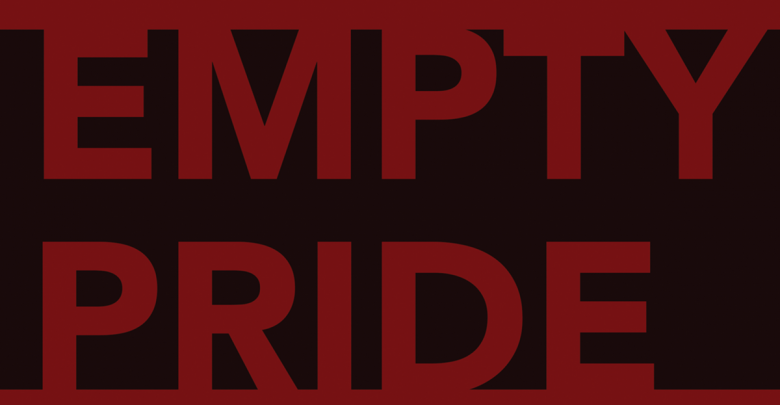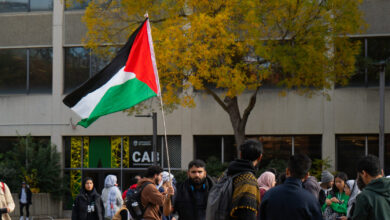 Jessica Tang
Jessica TangOn June 9, 2018, Edmonton’s annual Pride parade was stopped for more than half an hour when a group of queer and trans people of colour and their allies blocked its route. The demonstrators handed out leaflets with the following demands:
WE DEMAND:
1. That the Pride Society uninvite the RCMP, military, and Edmonton Police Service from marching in future parades.
2. That the society re-structures its board and staff hiring practices to have more representation from people of colour and trans folks.
3. That more well-funded spaces specifically designed for people of colour and trans folks be included in the festival.
4. That all mainstream pride spaces clearly acknowledge and honour pride’s history as a demonstration against police oppression.
The Edmonton Pride Festival Society consulted with the protestors and announced the EPS, RCMP, and military will not march in the Parade until all community members feel safe in their presence. Shay Lewis was one of the protesters and is now involved as a community member with the Pride parade’s community outreach committee that’s working to find a way forward for the festival in light of the protest.
Like many Pride parades, the Edmonton Pride Parade finds its roots in protesting police treatment of members of the LGBTQ community. It’s an often forgotten fact that, like in many other cities, the Edmonton Police Service orchestrated operations targeting the gay community. It was these acts of homophobia and discrimination, rather than some abstract aversion to the police, that fueled the initial Pride events in Edmonton.
Pride didn’t actually have a parade component in Edmonton until the 90s and wasn’t incorporated as an organization until 2003. It began quite simply as an event for the queer community to voice their demands to be heard. If you look at the Wikipedia entry on the Edmonton Pride Festival, you’ll find little beyond a terse recognition of these facts. The Edmonton Pride Festival’s website doesn’t even mention the original motives behind the parade, which would lead you to believe that the jovial nature we see currently is simply how it’s always been.
It’s this effective erasure of history that leads many to be so confused about the protest against police participation at the 2018 Pride Festival by a group of racialized queers and their allies, including me. Without knowing about the history of police violence in Edmonton, like the Pisces Bathhouse Raid, it’s quite possible to see the police as victims of bias and discrimination.
What exactly happened at the Pisces Bathhouse Raid? The Pisces Bathhouse was effectively a place gay men could go for hookups with other gay men. Members only paid for access to the bathhouse, and sex, if it occurred, was not connected to the bathhouse. With no significant difference from bathhouses that had been around for 10 years or more, the subsequent raid by Edmonton police baffled many when it occurred in 1981. Spurred by a complaint that the bathhouse “gave gay people a bad name,” police used undercover officers posing as gay men to gather evidence. This evidence-gathering resulted in the eventual raid on the bathhouse with 40 officers, six RCMP officers, and two crown attorneys.
Roughly 56 men were arrested and photographed, and many of them ended up paying fines or serving jail time. Yet, by all accounts, there was little evidence that the Pisces Bathhouse was anything more than a bathhouse. Ultimately, one could presume the only “crime” the Pisces Bathhouse committed was being “too gay” in the eyes of the morality squad, the Edmonton Police Service group that handled these cases. This clear abuse of the law sparked outrage and protest, coalescing around what had until then been a seemingly invisible gay and lesbian community. For folks in the Edmonton queer community, it became clear they would need to fight for their rights, leading to strong support for events like Edmonton Pride.
In these early days, Pride wasn’t about having a fun time, but about fighting for the gay and lesbian communities’ right to exist and be accepted. Pride was politics; to go to Pride and not just exist, but gather publicly, was an act of resistance that demanded attention. It was a protest fuelled by outrage over police mistreatment and lack of government protection. Over time, it expanded to include the queer communities we know today.
Since the start of Pride, there have been some victories. There was the reading of “sexual orientation” into section 15 of the Charter of Human Rights in 1996, the legalization of same-sex marriages in 2005, and the adding of gender identity and gender expression to the protected grounds of the Charter in 2017. However, the legal victories the Canadian queer community has seen thus far don’t cover the full extent of issues that need to be addressed. Conversion therapy is still legal across most of Canada. An inability to access gender-affirming treatment leads to high rates of depression and suicide among the trans community. There’s a continued lack of services for non-binary folks. Given that these communities make up small minorities within the larger queer community, it becomes easy for cisgender, gay, and lesbian activists, when they see their personal goals achieved, to declare victory and shift to celebration despite the fact that there’s still work to do.
That focus on celebration was one of the sentiments that drove myself and others to protest at the Edmonton Pride Parade in 2018. The inclusion of the police in the parade, despite complaints from both the racialized queer community and other marginalized queer communities, was a clear failure to properly consider all the ways different members of the queer community have been and continue to be impacted by different forms of oppression like carding. For these groups, the current legal victories, while steps forward, still leave much to be desired. The political aspect of Pride is not just important, but necessary. In a way, the protest was simply bringing back an aspect of Pride that had mistakenly been abandoned. It’s important that we make space for those whose voices aren’t being heard. That the Pride Festival’s board agreed to the requests of the protesters — such as uninviting EPS, the RCMP, and the Canadian military from future Pride events — is a sign of how reasonable this is.
The question on many people’s minds has been where we go next from here. How can Pride reconcile the celebration it’s become and the protest that many need it to be?
Honestly, it’s in the best interest of everyone that Pride doesn’t become strictly one or the other. There’s merit to the arguments that the positivity of Pride is important given the harsh reality many of us live with; however, that positivity doesn’t require an apolitical stance, nor does it preclude using Pride as a platform for protest.
In regards to specific changes like police participation in the parade, some may find prohibiting police organizations from the parade contentious. But consider that earlier this year, the Edmonton Police Service chose to not issue an apology for past homophobic actions and then proceeded to defend those same actions. Regardless of your beliefs in regards to their practices, it’s clear that the Edmonton Police Service is not a strong ally of the queer community. If the Edmonton Police Service cannot even perform the most symbolic of formalities, they shouldn’t be represented at Pride.
Interestingly enough, many have contended that if we don’t invite the police due to poor allyship, then we would need to disinvite many other organizations for the same reason. That may be in the best interest of Pride. A smaller Pride, one focused more on promoting and building community, is likely a healthier thing for everyone involved. Being more selective of who participates lets us refocus the parade on the important messages and services that people should hear and access. As cool as it is that things like the parade have gotten so big, many important but smaller organizations get lost in the shuffle of banks and other corporations who do little more than show up with rainbow-coloured chapstick once a year.
We’ve reached a redefining moment for Pride, and it’s important that we consider the direction Pride takes carefully. For this reason, it’s important that Pride’s community engagement process is thorough and nuanced. Precedence will be set in regard to how we respond to protests internal to the community, how we value the voices of others, and what the values at the core of Pride actually mean, and this precedence should not be set lightly. Nothing is without consequences, but if we accept the status quo, we’re effectively throwing away the ability of Pride to demand change. Pride was built on demanding change, and to lose that ability would be tantamount to killing Pride. Injustice hasn’t died, so neither should Pride.




